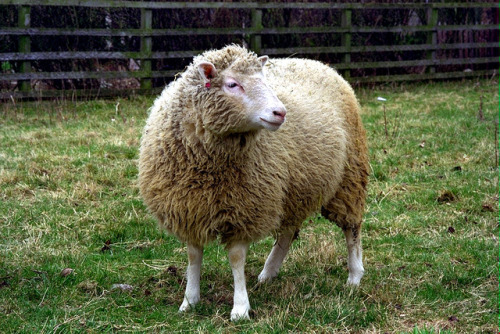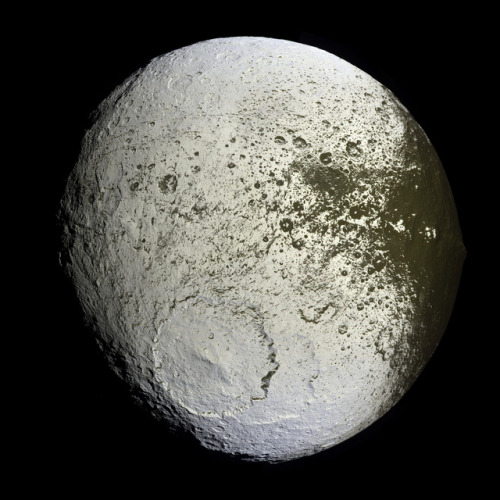Dolly At 20

Dolly at 20
Twenty years ago today on February 22, 1997, Ian Wilmut, Keith Campbell and colleagues at the Roslin Institute, announced the existence of a 7 month old sheep named Dolly, the product of cloning. She was cloned using and adult cell and born on July, 5, 1996 and raised under the auspices of the UK Ministry of Agriculture and Scottish company PPL Therapeutics. A Dorset Finn sheep, Dolly lived for six and half years before she was euthanized due to illness. Dolly was created with a process called somatic cell nuclear transfer, in which a donor cell (in this case and adult cell from another sheep) has the nucleus removed that is then transfered into an unfertilized egg cell (an oocyte) which in turn has had its cell nucleus removed to make way for the donor nucleus. The host cell is then stimulated and implanted into a host sheep for gestation. Although other animals had been cloned before Dolly, Dolly is celebrated as the first ‘clone’ because her donor cell came from an adult cell.

The word clone entered English as a noun used in botany in 1903 from the Ancient Greek word klon (κλον) meaning a twig or spray, related to klados (κλαδος) meaning a sprout, young offshoot, branch. Botanists used the word to describe the results of the techique of grafting a shoot of one plant or tree onto another. The word clone (verb) wasn’t used until 1959, and it wasn’t until the 1970s that clone was used in connnection with animals and humans. Since Dolly, scientists have successfully cloned many other animals, including pigs, horses, goats, and deer.
Image of ‘v’ graft courtesy ghadjikyriacou, via flickr, used with permission under a Creative Commons 3.0 license.
More Posts from Drunkscience4u and Others









Seven planets, including three habitable ones, found around ultra-cool dwarf star
“Unlike the worlds in our Solar System, each one should be tidally locked to the parent star, meaning that the same side always sees “day” while the opposite side resides in eternal night. Yet life on Earth began in the oceans, and of these seven worlds, the fourth, fifth and sixth might all have conditions to support liquid oceans or lakes – if the atmosphere is favorable – bathed in eternal sunlight.”
What is it that makes our Solar System special? It’s Earth, of course. A rocky planet of the right mass and composition, the right distance from our Sun, the right atmosphere, the surface oceans, and all the life that’s ensued is what makes us special. Not just special, but unique, at least among the planets we’ve found so far. But there are other planetary systems out there with Earth-like worlds. Similar to Earth in mass, size, temperature and many other conditions, these might represent planets where life similar to what we find here arose. For the first time, we’ve found a planetary system with not just one Earth-like, potentially habitable world, but three!
Come meet the worlds around the ultra-cool star TRAPPIST-1, and learn what the prospects are for these worlds being truly Earth-like.






Pan-STARRS solves the biggest problem facing every astronomer
“The science that came out of it alone is staggering. Nobody has had as much astronomical data in all of history as what Pan-STARRS has produced. They’ve discovered about 3,000 new near-Earth objects; tens of thousands of asteroids in the main belt, approximately 300 Kuiper belt objects (about a third of all the Kuiper belt objects ever discovered), and imaged a total of more than three billion verified objects. For those of you wondering, there’s no evidence for or against Planet Nine in the data, but the Pan-STARRS data does support that our Solar System ejected a fifth gas giant in its distant past.”
If you want to observe the night sky, it’s not quite as simple as pointing your telescope and collecting photons. You have to calibrate your data, otherwise your interpretation of what you’re looking at could be skewed by gas, dust, the atmosphere or other intervening factors that you’ve failed to consider. Without a proper calibration, you don’t know how reliable what you’re looking at is. The previous best calibration was the Digitized Sky Survey 2, which went down to 13 millimagnitudes, or an accuracy of 1.2%. Just a few weeks ago, Pan-STARRS released the largest astronomy survey results of all-time: 2 Petabytes of data. It quadruples the accuracy of every calibration we’ve ever had, and that’s before you even get into the phenomenal science it’s uncovered.
Come learn how it’s solved the biggest problem facing every astronomer, and why observational astronomy will never be the same!










Black Hole Caught Devouring Star For An Entire Decade
“Normally lasting weeks or months, a new record has just been set for TDEs. XJ1500+0154, 1.8 billion light years away, is the largest, longest-lasting one ever seen. First detected in July of 2005, the X-rays from this distant source brightened by a factor of 100 over 3 years. They remain bright even today. Although dozens of TDEs have been observed since the 1990s, none have lasted this long. It may be caused by the most massive star ever observed creating a TDE.”
When any object passes too close to the event horizon of a black hole, the tidal forces acting on it can become so strong that they’ll tear the entire object apart in a spaghettification disaster. While most of the matter will get ejected from the encounter, a significant fraction can be accreted, absorbed and used to fuel the black hole’s growth. These tidal disruption events have been seen numerous times since the launch of our X-ray observatories, and are now known to come in a wide variety of magnitudes, at a variety of distances and to last a variable amount of time. So when you see the largest, longest-lasting one ever, you sit up and take notice! That’s exactly what’s happened with XJ1500+154, which is now in its second decade of X-ray signals.
Come get the full story on this amazing object, and learn how it might solve the puzzle of supermassive black hole growth on today’s Mostly Mute Monday!

Hey guys, we made a flyer that you can print out and post in your places of choice! http://ift.tt/2jNXMm3
Please subscribe, like, comment, and donate! Next episode March 18. 2017. Starring: Candice Lola Directed by Rebecca Berger Produced by Rebecca Berger and Candice Lola Written by Candice Lola Editing, Color, Sound Design by Rebecca Berger Animation by Rachael K McDonald Links: Music: http://ift.tt/1JICaNj and http://ift.tt/2lquxdO http://ift.tt/2lINlQJ http://ift.tt/2lqtjzr http://ift.tt/2lIL08B http://ift.tt/2lqvuCQ (Donations are always welcome!) http://ift.tt/2lITyw7 http://ift.tt/2lqvQJO
The team behind Beauty of Science decided to explore the four seasons in this video combining macro footage of crystal growth, chemical reactions, and fluid dynamics. It’s always a fun game with videos like this to try and guess exactly what makes the mesmerizing patterns we see. Are those blue streaming waves in Spring caused by alcohol shifting the surface tension in a mixture? Are the dots of color welling up in Autumn a lighter fluid bursting up from underneath a denser one? As fun as the visuals are, though, what really made this video stand out for me was its excellent use of “The Blue Danube” to tie everything together. Check it out and don’t forget the audio! (Video credit: Beauty of Science; via Gizmodo)




-
 the--fault-in-our--scars reblogged this · 4 years ago
the--fault-in-our--scars reblogged this · 4 years ago -
 radiumrat reblogged this · 4 years ago
radiumrat reblogged this · 4 years ago -
 radiumrat liked this · 4 years ago
radiumrat liked this · 4 years ago -
 dumbhoe1023 liked this · 4 years ago
dumbhoe1023 liked this · 4 years ago -
 laudthesilence liked this · 4 years ago
laudthesilence liked this · 4 years ago -
 feistytucan reblogged this · 4 years ago
feistytucan reblogged this · 4 years ago -
 feistytucan liked this · 4 years ago
feistytucan liked this · 4 years ago -
 badgerhuan liked this · 4 years ago
badgerhuan liked this · 4 years ago -
 alolan-persians liked this · 4 years ago
alolan-persians liked this · 4 years ago -
 gamjane reblogged this · 4 years ago
gamjane reblogged this · 4 years ago -
 gamjane liked this · 4 years ago
gamjane liked this · 4 years ago -
 slasherbuppy liked this · 4 years ago
slasherbuppy liked this · 4 years ago -
 swimmingferret reblogged this · 4 years ago
swimmingferret reblogged this · 4 years ago -
 sarai-de-los-santos liked this · 5 years ago
sarai-de-los-santos liked this · 5 years ago -
 ophiostoma liked this · 5 years ago
ophiostoma liked this · 5 years ago -
 oscargago5 liked this · 6 years ago
oscargago5 liked this · 6 years ago -
 15th-century-shepherd reblogged this · 6 years ago
15th-century-shepherd reblogged this · 6 years ago -
 letslipthebirdsofwar-blog liked this · 6 years ago
letslipthebirdsofwar-blog liked this · 6 years ago -
 eyeswaitingfortuesdaynight reblogged this · 6 years ago
eyeswaitingfortuesdaynight reblogged this · 6 years ago -
 eyeswaitingfortuesdaynight liked this · 6 years ago
eyeswaitingfortuesdaynight liked this · 6 years ago -
 bifeamericano reblogged this · 6 years ago
bifeamericano reblogged this · 6 years ago -
 coughiccup liked this · 7 years ago
coughiccup liked this · 7 years ago -
 rebeleden liked this · 7 years ago
rebeleden liked this · 7 years ago -
 riotshotguns liked this · 7 years ago
riotshotguns liked this · 7 years ago -
 christmasdalek liked this · 7 years ago
christmasdalek liked this · 7 years ago -
 professionalghost liked this · 7 years ago
professionalghost liked this · 7 years ago -
 underseadevotee reblogged this · 7 years ago
underseadevotee reblogged this · 7 years ago -
 furryandfearless liked this · 7 years ago
furryandfearless liked this · 7 years ago -
 1houston-texas1 reblogged this · 7 years ago
1houston-texas1 reblogged this · 7 years ago -
 1houston-texas1 liked this · 7 years ago
1houston-texas1 liked this · 7 years ago -
 rayatui-blog liked this · 7 years ago
rayatui-blog liked this · 7 years ago -
 marcusshankerson-blog reblogged this · 7 years ago
marcusshankerson-blog reblogged this · 7 years ago -
 marcusshankerson-blog reblogged this · 7 years ago
marcusshankerson-blog reblogged this · 7 years ago -
 marcusshankerson-blog liked this · 7 years ago
marcusshankerson-blog liked this · 7 years ago -
 kdrama2017-blog liked this · 7 years ago
kdrama2017-blog liked this · 7 years ago -
 lucky-cigarette-blog reblogged this · 7 years ago
lucky-cigarette-blog reblogged this · 7 years ago -
 lucky-cigarette-blog liked this · 7 years ago
lucky-cigarette-blog liked this · 7 years ago -
 nothanksimnotastoner reblogged this · 8 years ago
nothanksimnotastoner reblogged this · 8 years ago -
 nothanksimnotastoner liked this · 8 years ago
nothanksimnotastoner liked this · 8 years ago -
 comtedemoney liked this · 8 years ago
comtedemoney liked this · 8 years ago -
 noire-atome liked this · 8 years ago
noire-atome liked this · 8 years ago
The official page of Drunk Science! An enthusiastic host performs simple experiments and then humorously explains the science behind the result, all while visibly drunk.
126 posts


